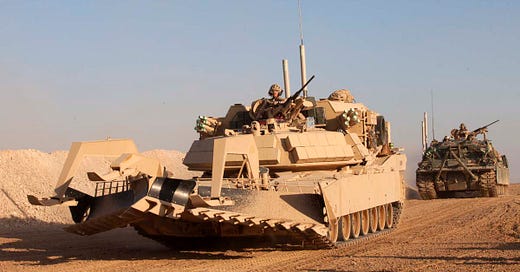
A U.S. Strategy for Ukraine…Finally
A Ukraine strategy has apparently been delivered to the U.S. Congress. What might this U.S. strategy look like and what impact will it have?
The only time Ukraine and the West will be able to seriously claim a true victory is when, and if, the fighting ends in an acceptable peace. This means the United States and its partners need to look beyond the current battlefield. They need to determine what grand strategy they should pursue to shape the longer-term course of the war and its lasting outcome. Anthony Cordesman, February 2023.
In the past 24 hours, it has been reported that the Biden administration has finally submitted a strategy for supporting Ukraine to the U.S. Congress. As Reuters reported:
A congressional aide said the long-awaited report had reached lawmakers on Monday and they had not yet had a chance to review it. Two other sources, requesting anonymity to discuss a classified matter, confirmed that it had been delivered. The White House did not immediately respond to a request for comment.
The strategy, which is linked to ongoing U.S. assistance for Ukraine, was due to have been submitted to Congress back in June. Given the war is now in its 31st month, the lack of a strategy until now says much about the prevarication and strategic timidity demonstrated during the war by many (but not all) of Kyiv’s backers.
The aim of this article to explore the current U.S. strategy for Ukraine, and what the new strategy, submitted in the dying days of the Biden administration, might look like and whether it will have an influence on the trajectory of the war.
The Current U.S. Strategy
There is no clear U.S. strategy for the war in Ukraine. After 31 months, the Biden administration is still using crisis management, speeches and slogans such as ‘for as long as it takes’ rather than developing and executed a clear, well resourced strategy for Ukraine.
I explored this issue in my new book, The War for Ukraine. The key elements of the U.S. approach since the beginning of the war have been as follows:
Providing military and economic assistance to Ukraine.
Rallying international support to provide economic, humanitarian and military assistance.
Leading the development and implementation of economic sanctions.
Avoiding a war between the U.S. and Russia.
The former Chairman of the Joint Chiefs, General Milley has described four desirable strategic outcomes:
No. 1: ‘Don’t have a kinetic conflict between the U.S. military and NATO with Russia.’ No. 2: ‘Contain war inside the geographical boundaries of Ukraine.’ No. 3: ‘Strengthen and maintain NATO unity.’ No. 4: ‘Empower Ukraine and give them the means to fight.
The lack of a clear U.S. strategy for Ukraine is hardly a new issue. Several organisations have proposed strategies for the U.S. approach to the war. In May this year, the Center for Strategic and International Studies proposed a plan for Victory in Ukraine encompassing five strategic initiatives. You can read that report here.
Another effort, included in a joint report from the U.S. House Foreign Affairs Committee, House Armed Services Committee, and the House Permanent Select Committee on Intelligence proposed a Plan of Victory in Ukraine. In particular, it recommended the following:
A path to victory for Ukraine will require (1) providing critical weapons to Ukraine at the speed of relevance, (2) tightening sanctions on the Putin regime, and (3) transferring frozen Russian sovereign assets to Ukraine.
Over time, the aspirations (with no accompanying strategy) of the Biden administration appear to changed. While initially supportive of driving Russia from Ukraine, the outcomes of the 2023 Ukrainian counter offensive apparently resulted in the Biden administration to shift its focus from total victory to one where Ukraine is ‘better postured for negotiations’.
This was probably informed by the view that Ukraine would not be able to undertake the offensive operations to liberate its territory. This is an impression the Ukrainian Kursk campaign is designed to challenge and change in the U.S. and beyond.
What might a U.S. strategy for Ukraine look like?
A New Hope: The Strategy Submitted to Congress
The reports of the U.S. strategy being submitted to Congress come as Iran steps up its support to Russia through the provision of Faith 360 ballistic missiles. It is unlikely that these missiles will be accompanied by restrictions on their use. They will however allow Russia to step up attacks on Ukrainian troops in Kursk as well as civilian targets within about 100km of the Russian border.
In the past few weeks, the Ukrainian president has also been discussion a Ukrainian Victory Plan, which is due to be briefed to President Biden and other Ukrainian supporters this month. I explored this Victory Plan, and the need for a clear theory of victory in Ukraine, in this recent piece. Whether the U.S. strategy, and the Ukrainian Victory Plan, are aligned or not will be a key factor in whether the new U.S. strategy is effective.
The new U.S. strategy, while reportedly classified, probably wont stay that way for long. It was submitted to the U.S. Congress, in Washington DC. Keeping this strategy secret for too long is difficult to imagine.
That said, what might an explicit U.S. strategy seek to achieve, and what might its major components be? In essence, what will be the purpose of the strategy and its key lines of effort?
The most important element of the strategy will be the purpose of U.S. support that is described in the document. Based on a realistic diagnosis of Ukrainian and Russian capacity, and the current situation in the war, the purpose should include a clear vision of the outcome, or the end state, that the U.S. seeks in the war.
The strategy should make clear that American interests in both Europe and the Pacific are impacted by the war in Ukraine; the strategy needs to provide a compelling purpose for supporting Ukraine that achieves security in Europe, deters aggression in the Pacific and reassures European and Asian allies that the U.S. remains a reliable and consistent ally and security partner.
As to a clear end state, the strategy might employ existing statements on Ukraine such as a 2022 opinion piece from the U.S. President. Biden wrote in a May 2022 New York Times op-ed about Ukraine that “America’s goal is straightforward: We want to see a democratic, independent, sovereign and prosperous Ukraine with the means to deter and defend itself against further aggression.”
However, a clear end state is insufficient. What strategic tasks might be needed to achieve this?
As I have written over the past year or so, purely ‘defending Ukraine’ is insufficient. The new U.S. strategy, if it is to have any impact, must shift to ‘defeat Russia in Ukraine’ as a key goal. This is a clear objective, would influence thinking in Europe as well as messaging Putin that he will not be allowed to ‘win by waiting out’ the West. This objective to beat Russia - for Ukraine to win - should also inform the amount and pace of support for Ukraine from the U.S. and others.
Another objective must be to sustain the international coalition that is supporting Ukraine. Across an array of military and economic support initiatives, this coalition is providing an enormous amount of support to Ukraine and this need to be sustained, if not increased in size and speed of delivery.
A third objective should be investment in defence industry to hasten support to Ukraine, rebuild U.S. war stocks and to deter Chinese adventurism. The arsenal of authoritarians have been able to ensure Russia has a continuous flow of arms and munitions for the war. This must be addressed through increased defence production in the US, and among its allies, as well as additional sanctions and covert action to interfere with defence production in Russia and unfriendly nations.
A fourth objective will be achieving increased diplomatic support for Ukraine from the international community and lessen the tendency of fence-sitting nations to tacitly support Russia through procuring cheap energy or not supporting Ukraine in the United Nations. Related to this must be increased efforts to counter Russian misinformation, and its amplification by countries such as China.
These objectives would underpin ‘winning the war’. But a U.S. strategy should also anticipate and support Ukraine ‘winning the peace’.
Winning the Peace objectives would include security guarantees for Ukraine (including support for its entry into NATO and bilateral arrangements), support for reconstruction in Ukraine and the support for pursuing and prosecuting Russian war criminals. Collectively, this will probably be a decades-long undertaking.
Nothing in this proposed strategy is simple, cheap or quick. But that is not what strategy is about. The U.S. will need to move beyond policies and statements which provide instant gratification to a strategy that underpins a theory of victory for Ukraine, guarantees its long-term security – and provides reassurance for other U.S. allies about the capacity and reliability of the U.S. in Europe and other parts of the world.
Impact on the War
The impact of the new U.S. strategy will be influenced by several factors.
The first and most obvious is that the Biden administration has only several months left. Even if a Harris administration is sworn in early in 2025, it is likely there may be some differences in approach to the war in Ukraine. Harris is clearly an Ukraine supporter, which she reinforced during the Presidential debate today. If Trump wins in November, the Biden administration strategy will have very limited impact because it is likely to be ‘cancelled’ in January 2025.
A second factor that will drive whether the U.S. strategy has an influence on the trajectory of the war is whether it takes a more ambitious course or not. If the strategy is more of the same of what we have seen in the past 31 months, the impact of the strategy will be limited. However, if it embraces a more courageous view of the war, including a defeat of Russia in Ukraine, it will change thinking in Kyiv, Moscow and Brussels. This would be welcome, but we should have low hopes of such an outcome.
A third factor, as I mentioned early in the piece, is how aligned the Biden strategy for the war is with the Ukrainian Victory Plan. That the U.S. strategy and the Ukrainian Victory Plan being discussed or announced in the same month is hardly a coincidence. However, that does not mean they have been synchronised. But a level of synchronization will be essential if the new U.S. strategy is to have any real impact on the trajectory of the war.
A final factor in how influential this strategy might be is its relationship to U.S. policy for its approach to confronting authoritarianism. While Russia poses a major threat to its European neighbours (as well as its Asian neighbours), it is one of four authoritarian powers who are now working towards a common goal: a decline in the influence, security and prosperity of the U.S. and the West more generally. The U.S. strategy for Ukraine must support, and be part of, this wider, long-term confrontation with the Big Four authoritarians.
A Strategy for Help Ukraine Win?
Time will tell whether the new U.S. strategy shifts thinking about U.S. support for Ukraine – in Congress and among U.S. citizens – or if it charts a course for more of the same. It could be a consequential document that sets a different and more audacious policy for U.S. support to Ukraine. Alternatively, it might be just more of what we have seen from the Biden administration in the past 31 months, and then die a quiet death in early 2025.
But, once it is leaked, which is almost certain, many will be watching for insights to hopefully answer a key question that remains unclear at present: does the U.S really want Ukraine to win?

















Would Biden take the heat for Harris and authorize Ukraine to unleash long range arms against military targets, military infrastructure and refined fuel storage?
The UK according to some reports wants to loosen the restructions on targeting. If Biden, the UK and France simultaneously agreed it would be powerful and the damage may spare ukranian infrastructure attacks this winter and be the beginning of the end.
Finally. I remember asking you a question about this on the Mriya Report. What would you say to the National Command Authority what your response would be if you were the chairman of the joint chiefs and were asked to write up a plan for Ukrainian victory.